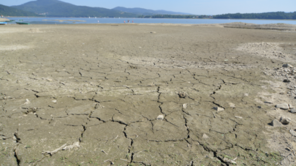How is the drought coming?Why is it so difficult to predict its effects? Where to look for data that will help to prepare a catalog of activities to reduce the losses caused by it? The team of Teraz Środowisko (Environment Now) magazine talks to dr Małgorzata Stolarska about the work on the project “Development of a plan to counteract the effects of drought”.
Teraz Środowisko: Drought and its effects were at the center of attention this year, both due to the World Water Day and the ongoing work on the plan to prevent the effects of drought in Poland. Let’s start with how the drought is coming?
Małgorzata Stolarska: In the phenomenon of drought, there is no expression of sudden emergence, as in the case of floods, for example. Droughts do not start in a single point or even linearly. They develop on an area. The process starts with no precipitation, the longer the percolation period lasts, the more plants react, the lowering of the water level in the rivers begins and the deficit of shallow groundwater becomes visible. Drought is simply coming slowly, and the assessment of the area it has affected is complex. It looks different than in a flood, where the extent of flood waters is visible to the naked eye.
TŚ: Why is the drought problem so complicated then?
MS: In the area of the water management, it is not always the case that if we have atmospheric drought all over the country, i.e. it is warm and there is a rainfall deficit, then every water intake is at risk of not providing water to users. Drought has different effects at different periods. From the point of view of farmers, each type of crop has its own requirements, so for some there will be no losses when the drought comes at the end of the growing season, but in the case of others, it might be yes.
On the other hand, the withdrawal of the drought phenomenon is long-lasting. The mere occurrence of precipitation does not mean that water deficits disappear. Water is needed to rebuild water resources. Last year, precipitation in annual terms was on an average level. It was raining, but the temperatures were so high that the rainwater evaporated almost immediately. Will it be the same with another drought for a given area? Maybe yes, maybe not, and maybe drought will not be here but it will appear in a completely different area.
The drought issue can not be treated in terms of 0:1. It is important to listen to the voice of water users affected by this phenomenon, remembering that the drought is not one-dimensional and manifests itself in four types, i.e. atmospheric drought, agricultural drought, hydrological and hydrogeological drought. Identification of areas (in spatial and economic terms) of the occurrence of drought effects is an important element of monitoring this phenomenon. Collecting and identifying information on actual losses enables building drought risk management tools so that the prevention and support is as effective as possible.
TŚ: Listening to this voice is one of the stages of the “Stop Suszy!” Project, the aim of which is to present a Plan to counteract the drought effects on river basins (PPSS). Within the project a survey was carried out. Who was the questionnaire sent to?
MS: In this project, the stakeholder group is very wide, because at every stage the drought causes effects and affects many sectors of the economy. The survey was sent to the public administration dealing with recording losses caused by drought, institutions in the crisis management system and participating in the processes of implementation of measures to eliminate and mitigate the effects of drought. The survey also included entities exposed to the effects of drought in Poland. They answered questions tailored to their profile in terms of: environmental, social and economic sensitivity to drought and reported planned measures for the coming years or already implemented measures to counteract the effects of drought by inter alia increasing retention, construction or reconstruction of water facilities as well as important education and research of drought. The rate of return of the questionnaire was 73.4 percent, which is a very good result, considering that there was no legal obligation to complete it (1).
TŚ: Will the results of the surveys be verified? I mean, can you continue working on materials that may be biased?
MS: We received surveys filled in a sensational manner and we know that we will draw full of them, but on the other hand there were situations in which the information provided in the survey was incomplete.
Aiming to answer your question, the verification of the survey results is mandatory when preparing planning documents. Survey is one of the data sources in the topic. They must be compared with all existing planning documents in Poland related to the drought, as well as all registers and records that collect information on drought or drought-related elements.
TŚ: What are these documents and what is their content?
MS: Among others Flood risk management plans that cover many investments. Most of these investments are not related to drought, eg flood embankments, but these plans also include planned investments in the retention of water in artificial reservoirs. The project will analyze whether they actually meet the premise to qualify as an action to counteract the effects of drought. The same applies to all notified planned investments. Very often the respondents were to give (and they did) when they plan their investments and at what level they are advanced. The survey also allowed to define the desired actions, which, for example, were taken in the past, but something limited them, and now the project lies in a drawer and waits for a better moment. Also, reporting such plans, even generally as an idea from a given unit gives us the chance to reach those needs that arise directly from the affected area.
The survey is needed in order not to implement the project only through the mere review of documents and records, but to directly ask the stakeholders struggling with the drought problem.
TŚ: So it was important to make direct contact?
MS: Precisely
TŚ: Was it possible to determine who suffers the effects of the drought the most at the level of the survey? Were they, for example, hydroelectric power plants, LGUs, entities from the agricultural industry … Or does it affect so many entities from various industries that you will not risk pointing out the most endangered?
MS: I think that it is impossible to assess this at a given stage. When it comes to agriculture, the answers were very clear. Some companies, for example, water and sewage, or energy – also signaled that they are either already dealing with the drought problem or they want to take care of it. I will not risk such a statement, because it would be exaggerated.
In the next stages of the project we should find out who is most affected by the drought and for whom it generates the greatest losses.
TŚ: A survey has already been carried out, now its results will be verified. Are there field tests planned in the next stages of the project?
MS: The plan is national, so we cannot carry out research on a national scale. We are here to identify areas threatened by drought with data from previous years to check what the repeatability of phenomena was. On this basis we can approximate how this area should prepare for further droughts.
TŚ: The answer to the question “How to prepare for further droughts?” will be the final stage of the project?
MS: Yes, a list of measures will be prepared to be implemented to reduce losses due to drought. For this reason we need to carry out a number of analysis: drought risk analysis, then drought exposure analysis and disposable resource analysis. If we look at the provisions of the Water Law Act, then – in the subject of drought – we first find that it is necessary to verify the disposable resources of surface and underground waters, quantify them in terms of the situation of disposable resources at the time of drought and recommend measures to increase these resources that are securing more water for the abstraction of drinking water or for industrial or irrigation purposes. Another element in the Water Law is proposals for measures related to increasing retention and changes in the way of using water; that also means changes in water and legal permits, as well as the construction of new water facilities to counteract the effects of drought. The last element of the plan to counteract the effects of drought is to catalog all these activities in a spatial relation.

dr Małgorzata Stolarska
Kierownik zespołu w projekcie dla PGW Wody Polskie
„Opracowanie planu przeciwdziałania skutkom suszy”
Przypisy:
1/ Ankiety wypełniły: parki narodowe i krajobrazowe, Lasy Państwowe, stowarzyszenia ekologiczne i gospodarstwa rybackie, związki i przedsiębiorstwa sadownicze, producenci mleka i bydła, plantatorzy – 13, izby rolnicze – 11, jednostki i stowarzyszenia związane z nasiennictwem – 2, elektrownie wodne, konwencjonalne i elektrociepłownie – 35, kopalnie – 22, przemysł wytwórczy –14, browary – 3, przedsiębiorstwa wodociągowe i komunalne – 38, izby gospodarcze – 3, stowarzyszenia związane z turystyką i żeglugą – 5. Ponadto ankiety zostały skierowane do jednostek samorządu terytorialnego i ministerstw.


